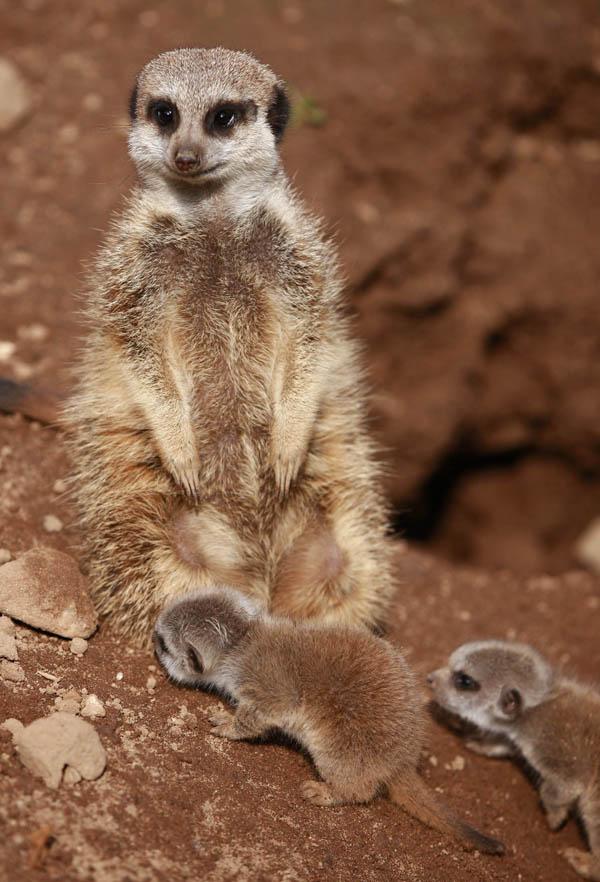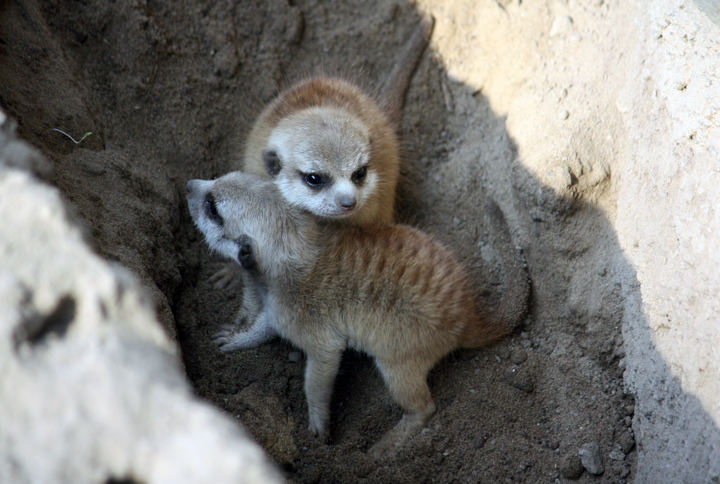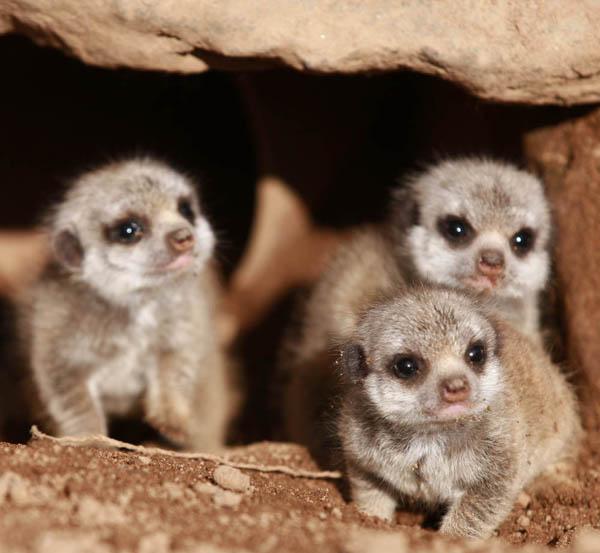Meerkat Facts

Meerkats are catlike carnivores that are part of the civets and mongoose family. They are identified by their long bodies; short, flat ears; and their ability to stand on their back feet. Meerkat coats can be gold, silver, orange or brown with dark patches of fur around the eyes.
Meerkats are small animals, measuring 9.75 to 11.75 inches (25 to 30 centimeters) from head to rump. Their tails add another 7.5 to 9.5 inches (19 to 24 cm) to their length. At less than 2.2 lbs. (1 kilogram), a meerkat weighs about the same as a squirrel.
Where do meerkats live?
These animals are found in the deserts and grasslands of Africa, including southwestern Botswana, western and southern Namibia, and north and west South Africa. They can also be found in the extreme southwestern areas of Angola and in the lowlands of Lesotho.

Meerkats live together in big groups. Several meerkat families may live together to form a community called a mob, gang or clan. Such a group can include three to 50 meerkats, according to the Natural History Museum, and the mob's dominant female leads the group.
Living in intricate tunnel systems underground called burrows, meerkats can stay safe from predators and cool during hot days. One burrow can have as many as 15 entrance and exit holes and can reach up to 6.5 feet (2 meters) deep, according to the San Diego Zoo. Unlike other burrowing creatures, meerkats live in more than one burrow; they keep several in rotation.
Every morning, meerkats start their day with grooming or lying in the sun. During the rest of the day, they forage for food. One meerkat will watch the group of foragers and alert them if a predator approaches. This sentry is relieved and replaced each hour so that everyone can forage.
What do meerkats eat?
Though they are considered carnivores, meerkats eat more than just meat. Their diet includes lizards, birds, bugs and fruit, according to the National Geographic. They also like to treat themselves to scorpions. Adult meerkats have some immunity to the venom, so scorpion stingers are no problem. However, instead of allowing pups to learn by trial and error and risk receiving a potentially life-threatening sting, mothers will cut the tail off of a scorpion before feeding the arachnid to her young, according to a 2006 study published in the journal Science.

Baby meerkats
Females give birth to one to eight babies at a time, but it is more common for meerkat mothers to have three to four offspring at a time. The babies, called pups, are born underground, where they are safe from predators. At birth, pups weigh 25 to 36 grams (0.9 to 1.3 ounces), according to the San Diego Zoo. In addition to being small, pups are also blind, deaf and almost hairless.
The whole family, including the father and siblings, pitches in to help raise the new additions. By nine weeks, the pups are weaned, and by one and a half years, the meerkats will be mature enough to have their own offspring. Meerkats live up to eight years in the wild and up to 13 years in zoos.
Classification/taxonomy
The taxonomy of meerkats, according to the Integrated Taxonomic Information System (ITIS), is:
- Kingdom: Animalia
- Subkingdom: Bilateria
- Infrakingdom: Deuterostomia
- Phylum: Chordata
- Subphylum: Vertebrata
- Infraphylum: Gnathostomata
- Superclass: Tetrapoda
- Class: Mammalia
- Subclass: Theria
- Infraclass: Eutheria
- Order: Carnivora
- Suborder: Feliformia
- Family: Herpestidae
- Genus & species: Suricata suricatta
- Subspecies: Suricata suricatta iona, Suricata suricatta marjoriae, Suricata suricatta suricatta
Conservation status
Meerkats are listed as "least concern" by the International Union for Conservation of Nature's (IUCN's) Red List of Threatened Species. There are currently no major threats to the animals, and their populations are doing well.
Other facts
Meerkat mothers can nurse their young while standing on their back legs. A dominant meerkat mom will force subordinates to nurse her young for her, according to a 2013 study published in the journal Animal Behavior.
When the pups are old enough, their mother will bring them live bugs and teach them how to kill the prey, according to the journal Science.
Young meerkats are so leery of birds that even airplanes will scare the animals into their burrows.
If the mob decides to move to another burrow, family members and other caretakers will carry pups by the scruff of the neck.
A membrane covers and protects meerkats' eyes while they dig.
When two groups of meerkats go to war over territory, they will line up and charge each other, much like human warriors did before modern technology. Meerkat wars can result in many deaths, so the animals try to avoid such conflicts by employing intimidation tactics, according to the San Diego Zoo.
Additional resources
Sign up for the Live Science daily newsletter now
Get the world’s most fascinating discoveries delivered straight to your inbox.











